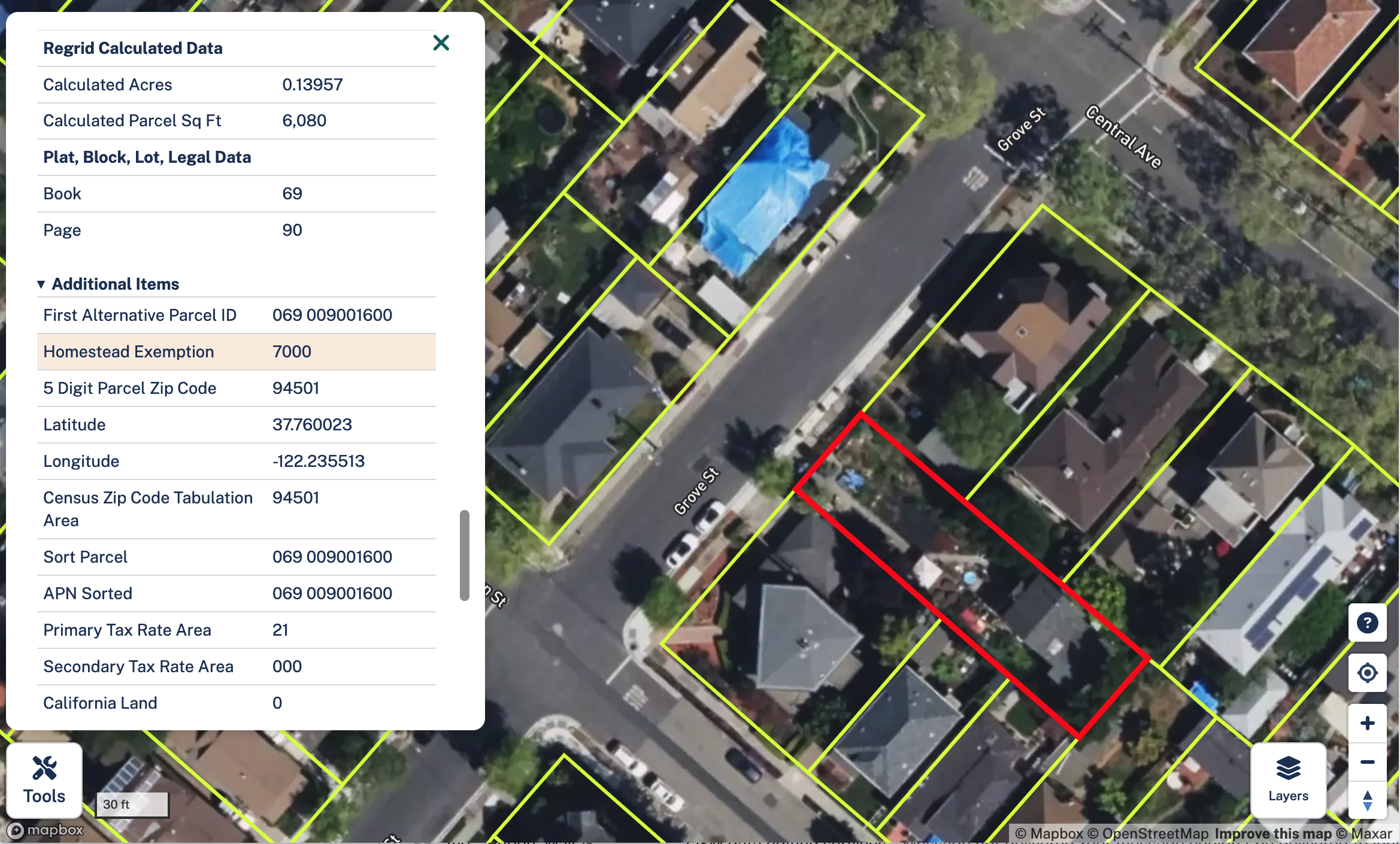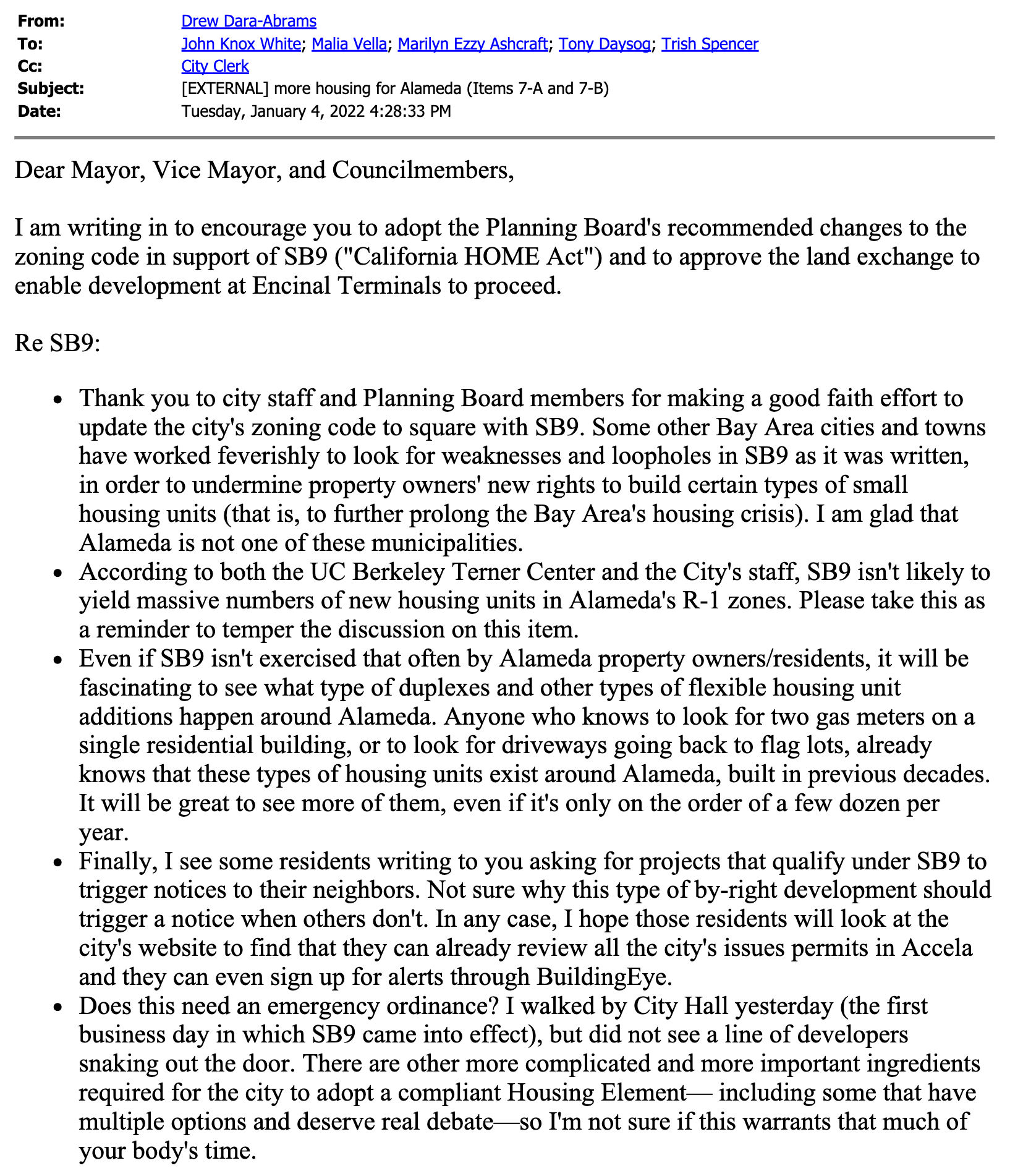Senate Bill 9 took effect in Alameda —and throughout California — at the start of January 2022. Leading up to that date, the predictions were dire: Developers would be lined up at Alameda City Hall, awaiting the first business day at which they could file under this new state law to split a single-family residential lot into two lots. How these developers would come to own single-family residential lots was unclear... but rereading meeting minutes, I see more than one public commenter saying they "fear[ed] that developers will take advantage of homeowners."
Commenters claimed that staff's proposed changes to the Alameda's zoning code to accommodate SB9 would potentially allow the transmogrifying of one single-family lot into 10 units of housing through complex chicanery of lot-splits, ADUs, and junior ADUs. The "Alameda Citizens Task Force" implored city staff to follow the lead of Los Altos Hills, Portola Valley, and Santa Barbara by immediately adopting an emergency ordinance. Without immediate action to preemptively nip and tuck the specifics of what could be built, SB9 would be abused to unleash countless housing units across the backyards and side yards and front yards and all other open space in the "R-1"-zoned parcels of Alameda's East End and Bay Farm Island!
That's not what's happened. There was no line at Alameda City Hall in January 2022. There were a total of zero uses of SB9 in Alameda in all of 2022. And likewise, zero uses in all of 2023.
It's only now in mid-2024 that Alameda has received its first (and so far only) application by a home-owner to use SB9 to split their single-family lot into two.
The geometry of this parcel highlights one of the main reasons why SB9 has not yet been used in Alameda — it's really only relevant to a very small number of extra deep or extra wide lots:

The project renderings show how two structures will fit, after the single existing lot is split into two:

For better or worse, there are only so many R-1 parcels around Alameda where this physically makes sense.
I think this pattern is similar to what I described earlier this year about Alameda's transit overlay: home-owners take advantage of this new zoning flexibility only when it's relevant to their specific lot size and shape and only when it's relevant to their actual goals.
The fears of NIMBYs that "developers" would somehow force home-owners to do things they didn't want to do was weird. In the projects I'm seeing so far, it appears that the property-owners are designing arrangements that work for themselves and their families — and that they're able to make use of the particulars of their lot to do a lot-split and an ADU in this situation or just an ADU in the other project I described in that previous blog post.
To be honest, I think Alameda's opposition to SB9 was a backhanded way of saying that opponents didn't trust their own neighbors. SB9 grants some new flexibility to the owners of "single family" houses. It provides a new tool for building smaller housing units. And it also marginally increases property values for home-owners who can take advantage of this. I do almost wonder if the last part is what opponents find offensive: In a sense, SB9 undoes the NIMBY pact of the "R-1" zone — it does do away with the idea of the "single-family residential zone." Now all R-1 lots in Alameda are potentially valued based on their future carrying capacity, which in some situations is slightly higher.
But that's all hypothetical. In the actual world of small and weird lot sizes, of high interest rates, of high construction costs... in this actual world, it turns out most people who can afford R-1 houses in Alameda just want to live in 'em as-is.
To be clear, this is a mixed blessing. For all of the angst about changing R-1 zoning in Alameda, the changes have not done much to-date to create new housing units in city's most pleasant and resource-rich neighborhoods. Even if SB9 removed the term "single-family residential zone" from Alameda's zoning code, there are still too few housing units to meet today's need and to redress our city's history of racial segregation.
While refreshing my memory of Planning Board and City Council meetings about SB9, I ran into one of my own emails. I expressed caution — but even my cautious estimates were way too optimistic:

"... even if it's only on the order of a few dozen per year," I write. Oh well, I was wrong.
At least we can now point to one use of SB9 in Alameda.
And now that we can see it works — and that the sky hasn't fallen — it's time for city staff and the Planning Board to evaluate what parameters can be further loosened to make SB9 relevant for more parcels and for more home-owners to consider.